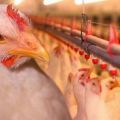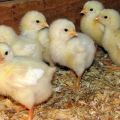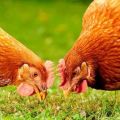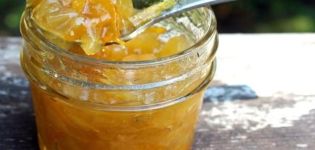Description and characteristics of the broiler breed of chickens Ross 308, table of weight by day
To obtain dietary chicken meat, broilers are bred, of which Ross 308 is one of the most productive. With proper maintenance, chickens gain 3 kg by 2 months, which makes growing a hybrid economically profitable. The bird is well suited for households due to its calm temperament, tender meat and an unusually high egg production for meat chickens.
Origin story
The Ross 308 broiler was introduced in the UK by Aviagen in the last century. Successful representatives of meat breeds served as genetic material, the main goal of the scientists was to obtain a hybrid that is rapidly gaining weight, and it was successfully achieved. Ross 308 is not a full-fledged breed, but a cross, which means that offspring with all the characteristics of a broiler cannot be obtained at home. Distribution rights for eggs, chickens and chickens are owned by Aviagen, a worldwide distributor of Ross 308 broilers sold under the Ross brand.
Description and characteristics of the broiler Ross 308
Chickens Ross 308 outwardly similar to other broilers with a strong constitution, developed muscles, a wide large carcass. It is difficult for a non-specialist to distinguish this cross in appearance from representatives of other meat breeds. What are the main characteristics of these broilers?
Bird appearance
The plumage of Ross 308 broilers is snow-white, blotches of other flowers are unacceptable, such birds are rejected. The skin is elastic, dyed in one light shade - these characteristics were given special attention when breeding to give the carcass a presentation. Broiler legs are strong, widely spaced, which indicates the presence of fighting breeds in the ancestors. Chickens Ross 308 have an oval body with a broad chest protruding forward. The broiler's head is small, topped with a bright red leaf-shaped crest, small catkins are also red. The weight of an adult bird reaches 5.5-6 kg.
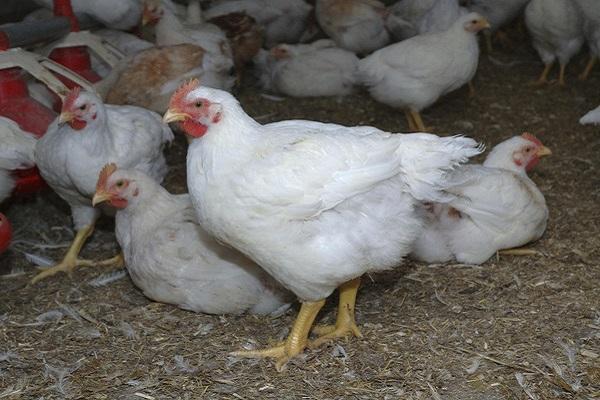
Temperament of the breed
Despite the fact that the blood of fighting cocks flows in broilers, Ross 308 chickens are absolutely not aggressive. They get along well with other inhabitants of the house. It is possible to keep in cages, since the cross gets used to different conditions of detention and withstands a sedentary lifestyle.
Maturation and egg production of layers
Ross 308 broilers are versatile: they are bred mainly for delicious dietary meat, but at the same time, chickens lay enough eggs for representatives of the meat breed. Birds begin to rush at the age of six months.
Meat indicators
The weight of an adult chicken reaches 5.5-6 kg, but broiler chickens are sent for slaughter earlier, starting from two months, with a set of 2.5-3 kg. With the right content, the daily weight gain is 55-60 grams. Up to 75% of meat is obtained from one carcass.
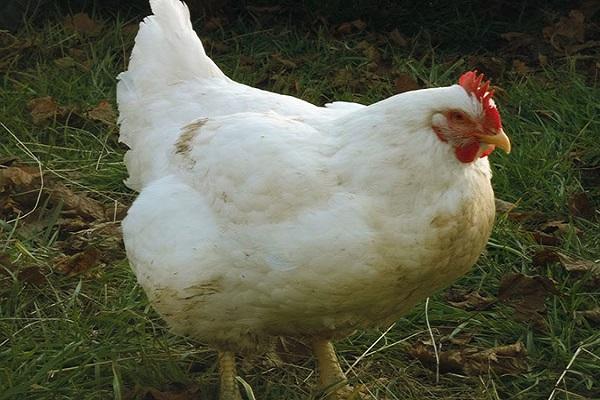
Egg standards
Despite the fact that the Ross 308 broiler is a hybrid of meat orientation, laying hens in terms of egg production are close to meat and egg chickens. With proper care, you can get up to 200 eggs per year. The egg weighs 55-60 grams.
Product quality
Chicken is a dietary product. Chicken meat is given to children, it is recommended to people on a diet, as well as during the rehabilitation period after an illness, since it is a source of protein, vitamin B and PP, ascorbic acid and beta-carotene. Soft broiler meat is suitable for making broths and second courses; it is served boiled, fried, stewed and baked.
Chicken eggs are indispensable in the diet, as they are rich in vitamins and trace elements, including calcium, potassium, phosphorus, copper, iron, iodine, cobalt, magnesium, manganese, boron and sulfur. Proteins are easily absorbed by the human body, they contain all the essential amino acids. Regular consumption of chicken eggs has a complex supportive effect on the body.
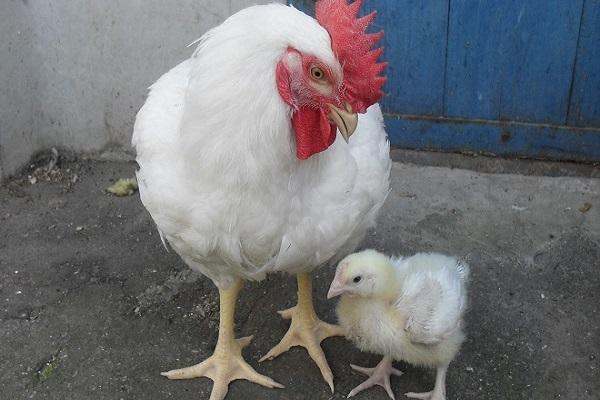
Advantages and disadvantages
The Ross 308 chicken has many benefits, which include the following:
- Fast weight gain.
- Versatility: in addition to dietary meat, you can get valuable eggs.
- Peaceful, livable character.
- Inactivity, allowing you to keep in cages, while significantly saving space.
- High survival rate.
- Keeping Ross 308 broilers is cost effective.
There are not so many shortcomings in the cross, and the most significant is the impossibility of obtaining offspring with all the characteristics of the parents at home. To breed broilers, you need to purchase eggs or chickens from a reliable supplier.
Another difficulty in keeping birds is the need for strict nutritional control. For chicks to be healthy and gain weight well, you should carefully monitor the diet, quality and quantity of feed.

As a disadvantage of Ross 308 broilers, their unstable immunity can also be noted. Birds often suffer from respiratory tract infections.
Growth table by day
Ross 308 chicks gain weight well from day one, as shown in the table below. Subject to the recommended conditions of detention and diet, they gain an average of 55 grams per day. This rate of weight gain is almost the highest among all existing crosses.
| Day | Live weight (in grams) | Daily gain (in grams) | Average daily gain per week (in grams) |
| 42 | |||
| 1 | 56 | 14 | |
| 2 | 72 | 15 | |
| 3 | 89 | 18 | |
| 4 | 109 | 20 | |
| 5 | 132 | 23 | |
| 6 | 157 | 25 | |
| 7 | 185 | 28 | 20,42 |
| 8 | 217 | 31 | |
| 9 | 251 | 34 | |
| 10 | 289 | 37 | |
| 11 | 330 | 40 | |
| 12 | 375 | 43 | |
| 13 | 422 | 46 | |
| 14 | 473 | 49 | 40,13 |
| 15 | 527 | 52 | |
| 16 | 585 | 55 | |
| 17 | 645 | 58 | |
| 18 | 709 | 60 | |
| 19 | 775 | 63 | |
| 20 | 844 | 65 | |
| 21 | 916 | 67 | 59,96 |
| 22 | 990 | 69 | |
| 23 | 1066 | 71 | |
| 24 | 1145 | 73 | |
| 25 | 1226 | 75 | |
| 26 | 1309 | 76 | |
| 27 | 1393 | 77 | |
| 28 | 1479 | 79 | 74,29 |
| 29 | 1567 | 80 | |
| 30 | 1656 | 80 | |
| 31 | 1746 | 81 | |
| 32 | 1836 | 82 | |
| 33 | 1928 | 82 | |
| 34 | 2020 | 83 | |
| 35 | 2113 | 83 | 81,56 |
| 36 | 2207 | 83 | |
| 37 | 2300 | 83 | |
| 38 | 2394 | 83 | |
| 39 | 2488 | 83 | |
| 40 | 2581 | 83 | |
| 41 | 2475 | 83 | |
| 42 | 2557 | 82 | 82,94 |
| 43 | 2639 | 82 | |
| 44 | 2721 | 81 | |
| 45 | 2802 | 81 | |
| 46 | 2882 | 80 | |
| 47 | 2961 | 80 | |
| 48 | 3040 | 79 | |
| 49 | 3118 | 78 | 80,16 |
| 50 | 3196 | 77 | |
| 51 | 3272 | 76 | |
| 52 | 3347 | 75 | |
| 53 | 3422 | 74 | |
| 54 | 3495 | 73 | |
| 55 | 3567 | 72 | |
| 56 | 3637 | 71 | 74,13 |
| 57 | 3707 | 69 | |
| 58 | 3775 | 68 | |
| 59 | 3841 | 67 | |
| 60 | 3906 | 65 | |
| 61 | 3970 | 63 | |
| 62 | 4031 | 62 | |
| 63 | 4091 | 60 | 64,84 |
| 64 | 4149 | 58 | |
| 65 | 4206 | 56 | |
| 66 | 4260 | 54 | |
| 67 | 4312 | 52 | |
| 68 | 4363 | 50 | |
| 69 | 4411 | 48 | |
| 70 | 4457 | 46 | 52,25 |
Growing features
Broilers can be kept in cages or in a house with a net or bedding as the floor. Regardless of which room is chosen for chickens, it should be disinfected before use and then ventilated. Equipment and supplies should also be processed to kill pathogens. Disinfection can be carried out using a solution of caustic soda, soda ash, formalin, or other means.
The broiler house must be closed. Lighting is installed around the clock. At night, you can turn on the red lamps, which provide both light and additional heating.
On a litter
In households, broilers are most often placed on bedding.The main requirement for it is good absorbency, which is achieved due to the sufficient dryness and looseness of the selected material. Wood shavings, sunflower husks, straw or sawdust are well suited for use as bedding. The thickness of the layer is chosen depending on the season: in winter at least 15 cm, in summer 5-7 cm is enough. The litter should be changed regularly to help prevent the spread of disease.
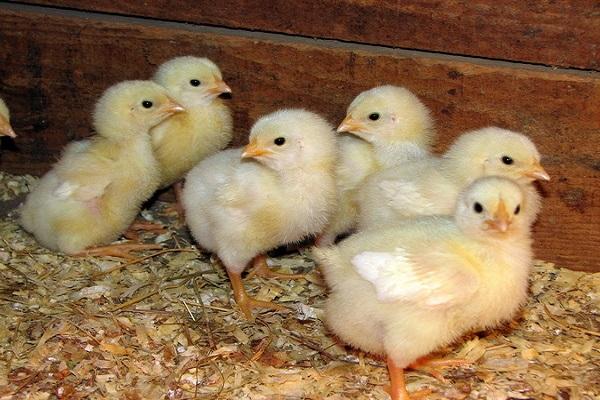
On mesh floors
The meshes of the net should be sized so that the birds cannot stick their paws in, but the droppings will fall through with ease. The net is pulled in the prepared poultry house, securing it with a wooden bar. The advantage of a mesh floor is that it helps you keep it clean without unnecessary work and also saves on bedding. More often, the mesh is used as a floor in large industries.
In the poultry house
When keeping in the house, care should be taken to keep it warm, for which heating is carried out in cold weather. The room must be sufficiently ventilated. Much attention must be paid to cleaning and disinfection so that chickens are not exposed to infections.
In cages
The disadvantage of cells is that it is difficult to clean and disinfect them properly. The main advantage is space saving, since the cages can be installed in several tiers. When raising birds in this way, it is important to ensure regular cleaning, temperature, humidity and ventilation.

When to worm?
Helminths are deadly to chickens if left untreated. One infected bird can spread the parasites to an entire flock. In addition, helminths get into eggs and meat, and therefore pose a danger to humans. To prevent helminthiasis, it is enough to take appropriate preventive measures.
Seasonal prophylaxis is carried out during the periods of the highest infection - in spring and autumn, for this, antihelminthic drugs are added to the feed once every 5 days for 2 months. Anthelmintic therapy is also carried out for newly acquired birds, the medicine is given to chickens up to 10 days of life.
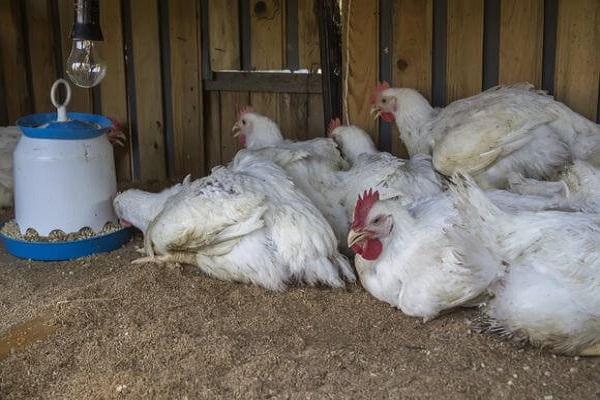
Features of the diet of crosses
For broilers, it is recommended to use special feed, but you can prepare the feed yourself, if you take into account the birds' need for a balanced composition required for weight gain. Feeders should be designed so that birds cannot rake feed with their paws. Dry food and water should be readily available. The diet of chickens and adult birds has a number of differences.
Chicks
Small broilers need to be fed properly from the very first days of life. Chickens are given millet for up to 5 days, sometimes chopped hard-boiled eggs are added. As a source of vitamins and minerals, finely chopped greens, sprouted barley and purchased complexes are introduced into the diet. Vegetables are introduced from the 10th day of life. At 2 weeks of age, it is advisable to switch to special mixtures for broiler chickens for rapid weight gain.
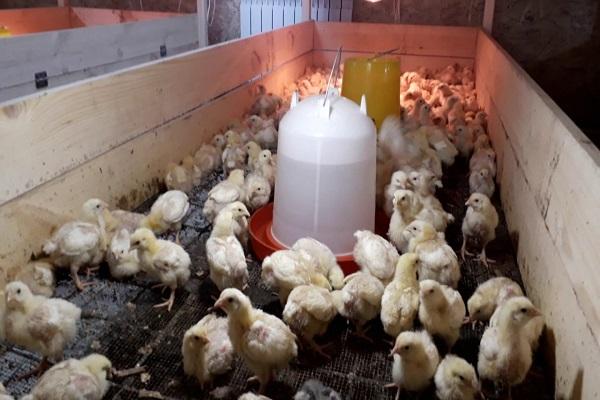
Adults
Adult birds can be fed with commercially available mixed feed with a balanced composition, which will provide the body with all the necessary substances - proteins, fats, carbohydrates, vitamins and microelements. If you choose your own diet, be sure to include in it a grain mixture of protein-rich varieties. In addition, the birds are given wet feed containing boiled vegetables, bran, vitamin and mineral supplements. A drinking bowl with clean water should be at the disposal of chickens at all times.
Incubation mode
The first priority should be given to the selection of eggs. Since it is impossible to obtain breeding material at home that is guaranteed to have the necessary characteristics, you need to find a bona fide seller. Products must be supplied with certificates, each egg must be labeled with the hybrid designation and production date.If you can choose eggs personally, you should carefully examine them for damage, giving preference to the same size, correct shape.
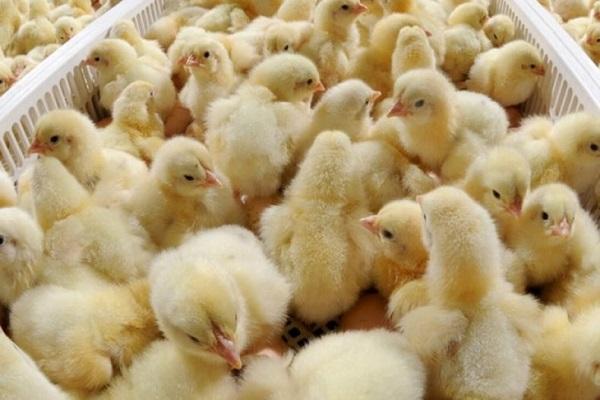
After setting the eggs in the incubator, follow the instructions for the device. Typically, the standard temperature for hatching chicks is maintained at about 38 degrees. The humidity is increased in the last 3 days so that the shell does not dry out and is not too hard, otherwise the chickens will not be able to break through it from the inside on their own.
Bird diseases and their treatment
Broilers can contract incurable diseases such as Marek's disease, aspergillosis, Newcastle disease, bird flu, chickenpox. Sick birds should be immediately separated from the flock and destroyed.
Diseases that respond to treatment include bronchopneumonia, salmonellosis, pullorosis, coccidiosis, and mycoplasmosis. Chickens are treated with antibiotics and other specialized medications.

In order to prevent diseases, it is necessary to vaccinate broilers and observe prevention. The following measures will help prevent disease:
- airing the room;
- maintaining the temperature and humidity in the chicken dwelling;
- protection against drafts;
- a properly selected diet rich in vitamins;
- regular cleaning and disinfection of the premises and equipment.
Ross 308 broilers are grown both in large-scale production and in households, as their rapid weight gain makes them economically viable. Hybrids are more demanding in care and maintenance than other chickens, but this is compensated by the rapid production of tasty tender meat.


